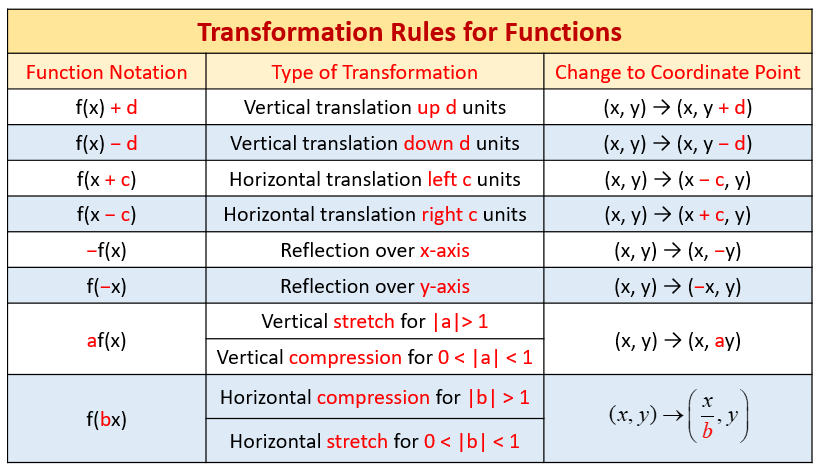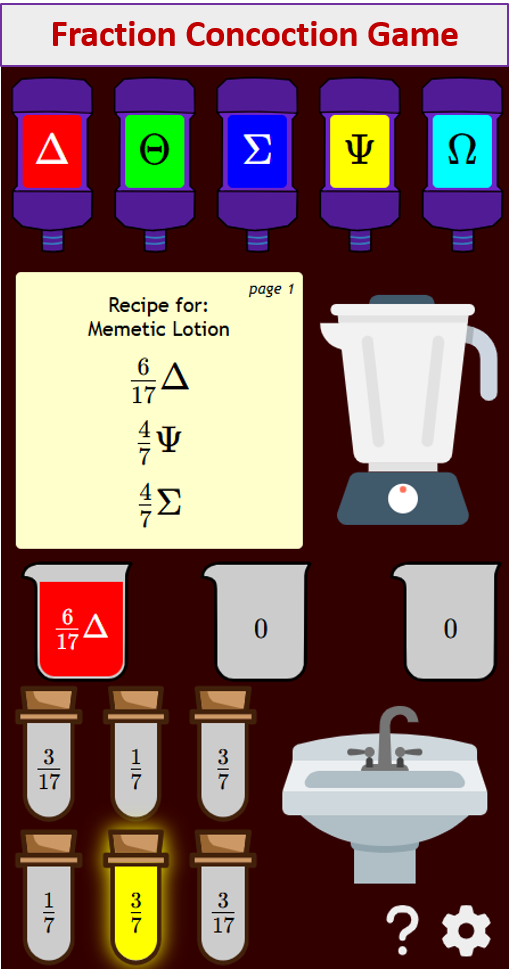Function Transformation
Related Pages
Graphs Of Functions
Parent Functions And Their Graphs
Transformations Of Graphs
More Pre-Calculus Lessons
Common Core (Functions)
These lessons with videos and examples help High School students learn about transformations of functions - how graphs of functions are affected by different transformations.
We will learn how to identify the effect on the graph of replacing f(x) by f(x) + k, kf(x), f(kx), and f(x + k) for specific values of k (both positive and negative); find the value of k given the graphs. Experiment with cases and illustrate an explanation of the effects on the graph using technology. Include recognizing even and odd functions from their graphs and algebraic expressions for them.
Common Core: HSF-BF.B.3
General Form:
A transformed function can be represented in the general form:
y = af(b(x - h)) + k
Where:
f(x) is the original function (the “parent function”).
a, b, h, and k are constants that determine the transformations.
The following table gives the transformation rules for functions: Vertical and horizontal translations, Reflection over the x-axis and y-axis, Vertical and horizontal stretch, Vertical and horizontal compression. Scroll down the page for examples and solutions on how to use the transformation rules.

Function Transformations Game
Practice your Function Transformation skills.
Function Transformations Game
Functions Transformations: A Summary
This video reviews function transformation including stretches, compressions, shifts left, shifts right, and reflections across the x and y axes. Scroll down the page for more explanations and videos.
Types of Transformations:
-
Vertical Shifts (Translations):
y = f(x) + k: Shifts the graph up by k units if k > 0, and down by |k| units if k < 0.
Example: y = x² + 3 shifts the parabola y = x² up by 3 units.
Example: y = x² - 2 shifts the parabola y = x² down by 2 units. -
Horizontal Shifts (Translations):
y = f(x - h): Shifts the graph right by h units if h > 0, and left by |h| units if h < 0. Note the minus sign in the formula.
Example: y = (x - 4)² shifts the parabola y = x² right by 4 units.
Example: y = (x + 1)² shifts the parabola y = x² left by 1 unit (because x + 1 can be rewritten as x - (-1)). -
Vertical Stretches/Compressions (Dilations):
y = a f(x):
If |a| > 1: Stretches the graph vertically by a factor of |a|. The graph becomes “taller."
If 0 < |a| < 1: Compresses the graph vertically by a factor of |a|. The graph becomes “shorter."
If a < 0: Also reflects the graph across the x-axis (see reflections below).
Example: y = 2x² stretches the parabola y = x² vertically by a factor of 2.
Example: y = (1/2)x² compresses the parabola y = x² vertically by a factor of 1/2. -
Horizontal Stretches/Compressions (Dilations):
y = f(bx):
If |b| > 1: Compresses the graph horizontally by a factor of |b|. The graph becomes “narrower."
If 0 < |b| < 1: Stretches the graph horizontally by a factor of 1/|b|. The graph becomes “wider."
If b < 0: Also reflects the graph across the y-axis (see reflections below).
Example: y = (2x)² compresses the parabola y = x² horizontally by a factor of 2.
Example: y = (1/3x)² stretches the parabola y = x² horizontally by a factor of 3. -
Reflections:
Reflection across the x-axis: y = -f(x). This flips the graph over the x-axis.
Example: y = -x² reflects the parabola y = x² over the x-axis, making it open downwards.
Reflection across the y-axis: y = f(-x). This flips the graph over the y-axis.
Example: y = √(-x) reflects the square root function y = √x over the y-axis. -
Order of Transformations:
When multiple transformations are applied, the order matters. Generally, follow this order (similar to the order of operations):
- Horizontal shifts (h)
- Horizontal stretches/compressions and reflections (b)
- Vertical stretches/compressions and reflections (a)
- Vertical shifts (k)
Function Transformations: Horizontal And Vertical Stretches And Compressions
This video explains to graph graph horizontal and vertical stretches and compressions in the form a*f(b(x-c))+d. This video looks at how a and b affect the graph of f(x).
af(x): a > 1, stretch f(x) vertically by a factor of a
af(x): 0 < a < 1, compress f(x) vertically by a factor of a
f(bx); b > 1, compress f(x) horizontally
f(bx); 0 < b < 1, stretch f(x) horizontally.
Function Transformations: Horizontal And Vertical Translations
This video explains to graph graph horizontal and vertical translation in the form af(b(x-c))+d. This video looks at how c and d affect the graph of f(x).
f(x + c): shift f(x) c units left
f(x − c): shift f(x) c units right
f(x) + d: shift f(x) d units up
f(x) − d: shift f(x) d units down
Identify Function Translations Using Function Notation
This video explains how to identify a shift up, down, left, and right given the translation in function notation.
Graphing Multiple Function Transformations - Part 1 of 2
Graphing Multiple Function Transformations - Part 2 of 2
Try out our new and fun Fraction Concoction Game.
Add and subtract fractions to make exciting fraction concoctions following a recipe. There are four levels of difficulty: Easy, medium, hard and insane. Practice the basics of fraction addition and subtraction or challenge yourself with the insane level.

We welcome your feedback, comments and questions about this site or page. Please submit your feedback or enquiries via our Feedback page.